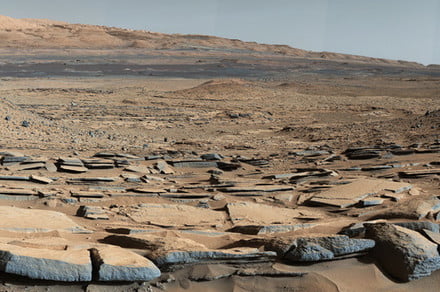A view from the base of Mars’ Mount Sharp taken by the Curiosity rover. The rock layers in the foreground dip toward the base of the mountain, indicating ancient water flow. NASA/JPL-Caltech
The Gale Crater, the dried up lake bed on Mars on which the Curiosity rover landed, could once have supported life according to scientists.
Using data from Curiosity and working alongside NASA’s Mars Science Laboratory’s Sample Analysis at Mars (SAM) and sedimentology and stratigraphy teams, Christopher House, professor of geosciences and director of the NASA Pennsylvania Space Grant Consortium, was tasked with determining if life could ever have existed in the now barren Gale Crater.
Curiosity detected lots of mudstone with fine layers in the locale, suggesting there was once water there. “Gale Crater appears to have been a lake environment,” House confirmed in a statement. “The water would have persisted for a million years or more.”
Eventually, the lake became filled with sediment and turned into stone. But just because there was no longer a lake, that doesn’t mean there wasn’t still water present near the surface. “The whole system, including the groundwater that ran through it, lasted much longer, perhaps even a billion or more years,” House explained. “There are fractures filled with sulfate, which indicates that water ran through these rocks much later, after the planet was no longer forming lakes.”
The team are particularly interested in the presence of sulfur gases, as these are given off by sulfate and sulfide minerals like pyrite. Sulfur is an essential element for life, and pyrite forms in sediment in the presence of organic matter. So detecting pyrite could indicate that the area once supported life.
The chemical makeup of the crater is studied by the SAM researchers who use an instrument which heats up rock samples, then measure the molecules given off using a mass spectrometer.
“It’s been fun to be involved in the daily operations, decisions like where to take a measurement, or where to drive, or whether we should prioritize a particular measurement over a different measurement given the limited amount of time on the surface,” House said. “Each day is limited by the power that the rover has and how much power the rover will need. It has been a great learning experience for how missions operate and a great opportunity to collaborate with scientists from around the world.”
Editors’ Recommendations
- Mars 2020 will capture high-definition color images from the Jezero Crater
- See a fly-over of Mars and track the path Curiosity will take up Mount Sharp
- Curiosity rover finds evidence that water once existed on the surface of Mars
- Armed and ready: Mars 2020 rover is fitted with its robotic arm
- Methane mystery: Curiosity detects highest-ever levels of methane on Mars

